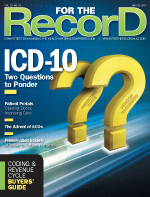 May 23, 2011
May 23, 2011
Coding for Cardiomyopathy
For The Record
Vol. 23 No. 10 P. 27
Cardiomyopathy is a progressive disease of the heart muscle with no known etiology. The condition makes it difficult for the heart to pump blood throughout the body. Although it may develop secondarily to a disease elsewhere in the body, such as coronary artery disease or valvular heart disease, the underlying cause may never be identified. Cardiomyopathy may lead to heart failure, blood clots, a heart murmur, and cardiac arrest.
The patient may not exhibit any signs and symptoms in the early stages of cardiomyopathy. As the disease progresses, patients may experience breathlessness with exertion or even at rest; swelling of the legs, ankles, or feet; abdominal bloating due to fluid buildup; fatigue; an irregular heartbeat; or dizziness, lightheadedness, and fainting. Signs and symptoms will progress unless the condition is treated.
There are three types of cardiomyopathy:
• Dilated cardiomyopathy (ICD-9-CM code 425.4) is the most common type in which the left ventricle becomes enlarged and can no longer pump blood throughout the body. This type generally occurs in middle-aged people. When the cardiomyopathy is associated with alcoholism, assign code 425.5 for alcoholic cardiomyopathy.
The most common type of dilated cardiomyopathy develops after a heart attack and is called ischemic cardiomyopathy (414.8). All ischemic cardiomyopathies are classified to code 414.8 (AHA Coding Clinic for ICD-9-CM, 1990, third quarter, page 15).
• Hypertrophic cardiomyopathy is an abnormal growth or thickening of the ventricle walls that causes a decrease in the amount of blood delivered to the body. This type most commonly occurs in childhood. Code 425.4 is assigned for hypertrophic cardiomyopathy unless the condition is documented as obstructive, which is classified to code 425.1. Congenital hypertrophic obstructive cardiomyopathy is assigned to code 746.84.
• Restrictive cardiomyopathy (425.4) occurs when the ventricle walls become rigid or stiff, making it difficult for the chambers to fill with blood between heartbeats. This type of cardiomyopathy usually affects older people.
Physicians may use the term “congestive cardiomyopathy,” which is also referred to as dilated cardiomyopathy and is characterized by ventricular dilation, contractile dysfunction, and symptoms of chronic heart failure (CHF). When a patient presents with CHF and cardiomyopathy, treatment is typically focused on managing CHF. Therefore, sequence a code from category 428, Heart failure, as the principal diagnosis with code 425.4 added as a secondary diagnosis (AHA Coding Clinic for ICD-9-CM, 1990, second quarter, page 19).
Hypertensive cardiomyopathy is classified to codes 402.9x and 425.8. A fifth-digit subclassification is required to identify the presence or the absence of heart failure (AHA Coding Clinic for ICD-9-CM, 1993, second quarter, page 9).
After a thorough physical examination, the physician may perform the following diagnostic tests if cardiomyopathy is suspected: a chest x-ray to determine whether the heart is enlarged; an echocardiogram to view the size of the heart and the motion as it beats; an electrocardiogram to show disturbances in the heart’s electrical activity to detect abnormal rhythms and areas of injury; cardiac MRI; cardiac catheterization to measure pressure within the heart chambers; or blood tests such as B-type natriuretic peptide, a protein produced in the heart that rises when the heart is subjected to the stress of CHF.
Treatment will depend on the type and the severity of the cardiomyopathy. Dilated cardiomyopathy may be treated with the following medications: an angiotensin-converting enzyme inhibitor to improve the heart’s pumping ability; an angiotensin receptor blocker; digoxin/digitalis to increase the strength of the heart muscle contractions and possibly slow the heartbeat; a diuretic to reduce fluid retention; or a beta blocker to improve cardiac function.
Hypertropic cardiomyopathy may be treated with medications such as beta blockers and calcium channel blockers to slow the heart’s pumping action and stabilize heart rhythms. If medications don’t work, then one of the following procedures may be recommended: septal myectomy, septal ablation, pacemaker implantation, or an implantable cardioverter defibrillator.
Restrictive cardiomyopathy mainly involves improving symptoms. A proper diet may be recommended to control salt and water intake. Medications such as diuretics, antihypertensives, and/or antiarrhythmics may be prescribed to help control symptoms.
If the cardiomyopathy has progressed to end stage, the patient will need a heart transplant.
Coding and sequencing for cardiomyopathy are dependent on the physician documentation in the medical record and application of the Official Coding Guidelines for inpatient care. Also, use specific AHA Coding Clinic for ICD-9-CM and American Medical Association CPT Assistant references to ensure complete and accurate coding.
— This information was prepared by Audrey Howard, RHIA, of 3M Consulting Services. 3M Consulting Services is a business of 3M Health Information Systems, a supplier of coding and classification systems to more than 5,000 healthcare providers. The company and its representatives do not assume any responsibility for reimbursement decisions or claims denials made by providers or payers as the result of the misuse of this coding information. More information about 3M Health Information Systems is available at www.3mhis.com or by calling 800-367-2447.
Coding for Cardiomyopathy in ICD-10-CM
Cardiomyopathy is classified to ICD-10-CM category I42, Cardiomyopathy. ICD-10-CM allows the different types of cardiomyopathy to have a unique code. The following are the codes included under category I42:
• I42.0, Dilated cardiomyopathy (includes congestive cardiomyopathy);
• I42.1, Obstructive hypertrophic cardiomyopathy (includes hypertrophic subaortic stenosis);
• I42.2, Other hypertrophic cardiomyopathy (includes nonobstructive hypertrophic cardiomyopathy);
• I42.3, Endomyocardial (eosinophilic) disease (includes endomyocardial [tropical] fibrosis and Löffler’s endocarditis);
• I42.4, Endocardial fibroelastosis (includes congenital cardiomyopathy and elastomyofibrosis);
• I42.5, Other restrictive cardiomyopathy (includes constrictive cardiomyopathy not otherwise specified [NOS]);
• I42.6, Alcoholic cardiomyopathy (also code presence of alcoholism [F10.-]);
• I42.7, Cardiomyopathy due to drug and external agent (first code [T36 to T65] to identify cause);
• I42.8, Other cardiomyopathies; and
• I42.9, Cardiomyopathy, unspecified (includes cardiomyopathy [primary] [secondary] NOS).
— Audrey Howard



